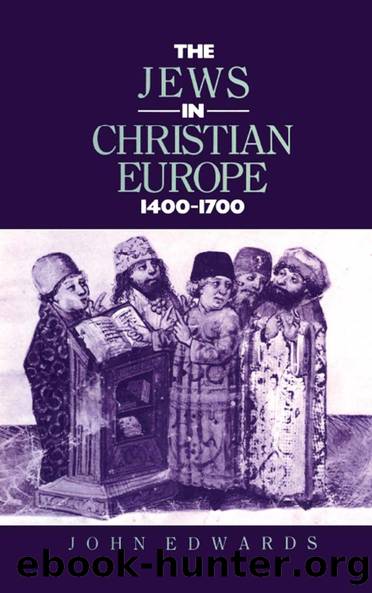The Jews in Christian Europe 1400-1700 by Dr John Edwards J. Edwards

Author:Dr John Edwards, J. Edwards [Dr John Edwards, J. Edwards]
Language: eng
Format: epub
Tags: History, General
ISBN: 9780415062138
Google: -HV_QgAACAAJ
Publisher: Routledge
Published: 1991-01-15T03:02:04+00:00
The Empire
After the many local expulsions of the period between 1470 and 1520, it did not appear that prospects for Jewish life in the Holy Roman Empire could be other than poor. However, German politics were never simple. The main figures who helped to ensure the continuity of Jewish settlement in the Empire, despite all pressures to the contrary, were, on the Jewish side, the leading rabbi in Germany, Josel of Rosheim, and, on the Christian side, the Emperor himself. Although Charles V was the main source of attempts to remove heresy, including âjudaizingâ, from his Netherlands territories, he and the remaining Catholic rulers in Germany, especially the prince-bishops, became the protectors of Jews against attack, above all from Protestants. Indeed, the record of the newly-Lutheran rulers in their treatment of their Jewish populations was not good, merely continuing the medieval tradition of hostility and expulsion, which had only been supported by Lutherâs own attitude to Judaism and Jews. Thus Jews were ordered to leave Saxony in 1537, and certain Thuringian towns such as Mühlhausen in the 1540s; there were riots in Brunswick in 1543, and further expulsions took place in 1553 from the duchies of Brunswick, Hanover, and Lüneburg. Trouble developed in the margravate of Brandenburg in the 1560s, and the Berlin synagogue was attacked in 1572. In 1573, a second expulsion of Jews from the whole of Brandenburg took place, and the pattern of hostility, leading to expulsion, was repeated in 1582 in Silesia, with the exception of three communities. To this it may be added that the practical attitude of Calvinists to Jews was very similar. The main Calvinist state in Germany, the Palatinate, had 155 Jewish families in 1550, but the Jewish population was expelled in 1575 by the Elector Frederick III.16
On the other hand it seemed, by various actions, that the Emperor wished to halt the exodus of Jews from Germany, so that, paradoxically, they were safer in states with Catholic rulers. The fact that Jews were technically under Imperial protection had not prevented violence and expulsions under Maximilian I, but Charles V, without apparently deviating from the traditional attitude towards the Jews which formed part of the medieval heritage which he devoted his life to upholding, seems to have concluded that he and his supporters needed the help of Jews in order to defeat the burgeoning Protestantism.17
The Imperial diets of Augsburg in 1530 and Speyer in 1544 were used to confirm the protected status of Jews in the Empire, but the most important measure taken by Charles Vâs government to protect the Jews was included in the 1555 Augsburg religious settlement. This explicitly excluded the Church states, ruled by prince-bishops, from the otherwise general rule that the prince should decide the religion of each state. The object of this move was to prevent any prince-bishop from becoming Protestant and turning the state into a conventional Lutheran principality, with consequences which might include the expulsion of the Jews, as was increasingly happening in existing Lutheran areas.
Download
This site does not store any files on its server. We only index and link to content provided by other sites. Please contact the content providers to delete copyright contents if any and email us, we'll remove relevant links or contents immediately.
| Civilization & Culture | Expeditions & Discoveries |
| Jewish | Maritime History & Piracy |
| Religious | Slavery & Emancipation |
| Women in History |
Cecilia; Or, Memoirs of an Heiress — Volume 1 by Fanny Burney(31336)
Cecilia; Or, Memoirs of an Heiress — Volume 3 by Fanny Burney(30935)
Cecilia; Or, Memoirs of an Heiress — Volume 2 by Fanny Burney(30891)
The Secret History by Donna Tartt(16635)
Sapiens: A Brief History of Humankind by Yuval Noah Harari(13059)
Leonardo da Vinci by Walter Isaacson(11907)
The Radium Girls by Kate Moore(10910)
Sapiens by Yuval Noah Harari(4540)
The Wind in My Hair by Masih Alinejad(4426)
How Democracies Die by Steven Levitsky & Daniel Ziblatt(4401)
Homo Deus: A Brief History of Tomorrow by Yuval Noah Harari(4282)
Endurance: Shackleton's Incredible Voyage by Alfred Lansing(3845)
The Silk Roads by Peter Frankopan(3764)
Man's Search for Meaning by Viktor Frankl(3636)
Millionaire: The Philanderer, Gambler, and Duelist Who Invented Modern Finance by Janet Gleeson(3571)
The Rape of Nanking by Iris Chang(3518)
Hitler in Los Angeles by Steven J. Ross(3439)
The Motorcycle Diaries by Ernesto Che Guevara(3338)
Joan of Arc by Mary Gordon(3260)
